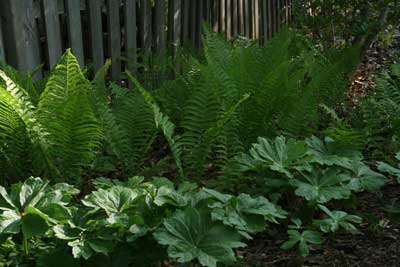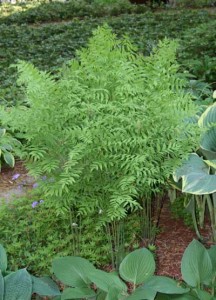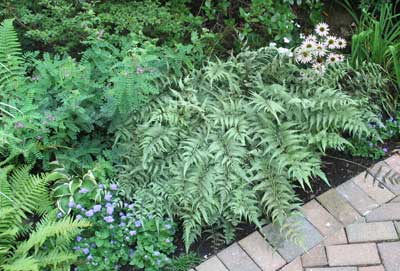Ferns – All the Colors of Green

Greetings, spore fans. It is said that Ireland has a thousand shades of green. That has nothing to do with ferns, and having been to Ireland I have to say that it’s green all right, but the subtle nuances escaped me. I digress and it’s only the first paragraph. So: garden ferns: like Ireland, mostly green. Pretty subtle, with some notable exceptions. Below are the ones that I have found to be the most reliable.
The ferns that we routinely carry are for the most part shade plants, little forest-floor guys. Probably the most sun-tolerant is the Sensitive Fern (Onoclea sensibilis), called that because at the first appearance of frost in autumn, it dies to the ground. It’s native and a colonizer—when happy it spreads aggressively; you’ll find it in the sun along the side of the road in ditches, along stream banks and so on.

I think the most shade-tolerant fern in my experience is the Autumn Fern, Dryopteris erythrosora. So called because the new leaves are sort of copper colored, like autumn leaves.
They are evergreen, and at my place perform happily in miserable conditions between a wall, a shed, and the shade cast by a nearby American Holly tree. They are about 24 inches tall, and have been thriving in that dead zone for about 4 years now.
Got moist spots? Three of the natives do well in wet soils with protection from afternoon sun: Cinnamon Fern (Osmunda cinnamomea), Royal Fern (Osmunda regalis) and Ostrich Fern (Matteuccia something).
They are happy in a rain garden or near a downspout or in that low corner of the yard, but also do okay in regular garden soil. The Ostrich is the most sensitive to drying out, and I find that by August they are looking pretty bad.

Cinnamon Fern is upright/arching, and the spores (fern “seeds”, dust-like and copper colored) are born on special fronds that look sort of like sticks of cinnamon. Ornamental, for a fern. The Royal fern has leaves that look more like an ash or locust tree; not very fern-like. The spores are borne at the top of the frond like a little crown. (Awww……) The Ostrich Fern has large ostrich-feather shaped fronds, and it has underground stems that allow it to colonize; aggressively in loose moist soil.
Another native colonizer, but about 18 inches tall instead of 3 feet like the Ostrich, is the light green Hayscented Fern (Dennstaedtia punctilobula). Hey, I’m doing these Latin names from memory: that one is easy to mess up so Pardon My Latin. It also spreads rapidly underground in loose soil, and in a formal garden, could be a nuisance. The crushed foliage smells like fresh hay.
If you have a drier location, the Christmas Fern (Polystichum acrostichoides) works well. Easy to spot in the winter on hillsides in the forests around here because it is evergreen, it is called Christmas Fern either because it is: a) green at Christmas, or b) because the individual fronds look vaguely like a Christmas stocking if someone points it out to you. I have had them growing for 25 years around the base of an enormous oak tree. They look a lot like the classic Boston Fern houseplant, a low arching clump, but dark green instead of light green. A non-native relative, the Tassel Fern, also does well here; more delicate with deep green leaves and copper colored ”hairs” on the stems for additional interest.

For colorful foliage it’s hard to beat Japanese Painted Fern and its various hybrids and cultivars. Athyrium niponicum ‘Pictum’ and Athyrium ‘Ghost’, two that we regularly carry. When the foliage emerges in the spring it is silver, often with burgundy highlights.
‘Ghost’ is light silver without the burgundy. Differences in the selections have to do with the intensity of the silvers and burgundies, and how long into the summer heat the colors hold. I have some that I planted 25 years ago that are wimpy little clumps; the newer selections can be breathtaking and are much stronger growers. Average garden soil for these.
The Japanese Painted is related to a native species, Athyrium filix-femina, or Lady Fern which is a good reliable upright fern for average soil. There is a hybrid called ‘Lady in Red’ which has red stems, same look, a little more colorful. Pretty subtle. Maidenhair Fern, Adiantum. I love ‘em. They are so delicate with their wiry stems and crape-paper thin foliage. Can’t grow them. I don’t think I provide the right conditions—they need cool, moist, good soil. And I find that slugs just adore them; I always find them covered with slug slime. So I have pretty much given up on them, but I bet you will do better.
And on and on.
As with any plant, meeting the conditions they grow in in the wild will improve your chances of success at home. If you want great Ostrich Ferns, plant them in a moist spot; if you don’t water very often (after the plant is established) then Christmas Fern is best. If you think slugs and snails are misunderstood and deserve a place in the garden, then by all means plant Maidenhair Fern. Ferns are generally considered to be deer resistant. I have had some trouble with rabbits in the last couple of years on both Japanese Painted Fern and Christmas Fern.

We carry a good selection of ferns through spring and into summer. If you are looking for a specific fern and want to know if we have it in stock, you can use the Contact Us form on our website or give us a call at (301)937-1100.
by Larry Hurley

What are the flowers in the last picture (with ghost and maidenhair fern)?
I took another look at the photo and noted several things. Along the way the photo was mislabeled, and there is no maidenhair fern in the photo. The flowers are (blue) ageratum, an annual; pink on divided foliage; and a whitish or pale pink echinacea.
This was taken on a garden tour in mid-summer in Saint Louis. Given that the echinacea and the ageratum do best in full sun and the fern likes its shade, it may be that a few plants were stuck in by the homeower to fill holes right before the tour. The echinacea is probably recently out of the pot.
The pink flower on the divided foliage is some sort of legume, my best guess is Lathyrus niger, which is pretty obscure but is sold by Jelitto Seed, the primary source of unusual perennial seed for wholesale growers.
Larry Hurley